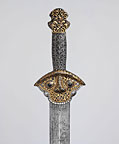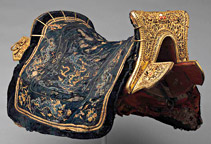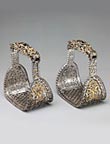
Horse Armor
|
|
Ersatz lacquer horse armor, the unique marriage
of varnished leather and iron lamellae, resilient and luminous with
layers of gold leafed lotus and peony blossoms, shellac (the insect
derivative, not true lacquer from the sap of trees), and tung oil
glaze, exemplifies the breadth of technique and artistic invention
inherent in Tibetan arms and armor, long discounted as unsophisticated,
generic types or overlooked entirely by those wholly unaware of
its existence. Blanketed by strong associations of modern day pacifism
in tandem with the Fourteenth Dalai Lama’s teachings, Tibetan
history is at the same time rife with warfare, riddled with conflict
spanning the seventh through mid-twentieth centuries—a context
which imbues each object with intense paradoxical undercurrents.
| |

Sword
|
Conjured from the maelstrom of eight tumultuous
centuries, astonishingly intact and heavily encrusted with dragons,
vegetal scrollwork, abstracted flames, clouds, and the monster
mask tsi pa ta, over 130 expertly crafted weapons of
brutal warfare and elaborate ceremony have been brought together
for the first time at The Metropolitan Museum of Art in New York
City, which from April 5-July 2, 2006 is presenting a laudably
comprehensive, inspired survey of traditional weapons and armor
from, ironically, the womb of Tibetan Buddhism, the Tibetan plateau.
Warriors of the Himalayas: Rediscovering the Arms and Armor
of Tibet, is at once a passionate ode to the warlike spirit
and force of arms of the Tibetans and also a dazzling showcase
of exquisite technique and command of decorative materials.
Exhilarating in the sheer range of components
adorning leather and iron, the principal elements decorating Tibetan
weaponry, the works in the exhibition attest to the facility of
artisans to seamlessly incorporate a staggering range of materials
into their creations—wood, leather, iron, copper alloys,
gold, silver, animal hair and skin, myriad gemstones, and textiles.
Four Matching Elements of Horse Armor (Tibetan or Mongolian,
15th-17th century) sprout a cascade of red yak hair; an elaborate
Saddle (Chinese for the Tibetan market, 17th-18th century),
remarkably similar to imperial Chinese saddles and comparable
to one made for emperor Qianlong (r. 1736-96), is paved with beautifully
integrated segments of silk, wood, ivory, coral, gold, silver,
iron, hair, leather, pigments, and tin; the exquisitely detailed
Three Jewels motif (Wish-Fulfilling Jewel, wheel, and lotus) on
the Quiver and Arrows (Tibetan, 17th-18th century) is
almost lost amongst the full set of gloriously feathered cane
or bamboo arrows; ray skin imparts an eerie feeling of marine
life abruptly halted in a distinctly animated Sword (Tibetan,
probably 19th-early 20th century) that still breathes.

Saddle |

Quiver and Arrows |

Set of Saddle,
Tack, and Sword |
From lamellar armor (crafted from horizontal
rows of diminutive overlapping plates connected by leather lacing)
and helmets, to cane shields, neck and breast defense for horses,
swords, scabbards, bridles, stirrups, harness fittings, and saddles,
the Tibetan works on view have been thoughtfully selected for
structural and historical interest, cross-cultural significance,
and refinement of surface adornment. Iron objects are of particular
interest, ushering in a wondrous spectrum of decorating techniques,
including pierced work, inlay, damascening, engraving with gold
and silver, chiseling, and embossing—often used in conjunction,
to dramatic visual effect.

Multiplate
Helmet
|
|
| |

Pair of Stirrups
|
Jarring study in contrasts, the exhibition
eloquently speaks of the aesthetic and functional duality of meticulously
decorated arms and armor created for warfare and eventually, later
in the twentieth century, preserved for ceremonial use—the
poignancy of a helmet’s floral scrollwork and finely realized
lotus petals obscured by the blood of enemies fallen in battle.
Exemplified by the forbidding Multi-Plate Helmet of Forty-Two
Lames (possibly Tibetan, Mongolian, or Chinese, 15th century),
impenetrable iron dome damascened in delicate gold and silver
blossoms, the depth, history, conflict, and artistry of Tibetan
culture is truly encapsulated. In Jekyll and Hyde strokes of unforgiving
violence and whimsical imagination, the galleries virtually pulsate
from the visceral power of the dichotomy of war and art. Two sets
of Tibetan armor for a horse and cavalryman, life-sized models
of man and beast, are imperious and resplendent, fully equipped
for war—unforgiving, brutal, and mythic, a human-equine
serpent scaled with iron plates. Yet on close examination to reward
searching gentle eyes, on either side of the slot for stirrup
leathers, tiny dragon heads are chiseled in finest relief.
|